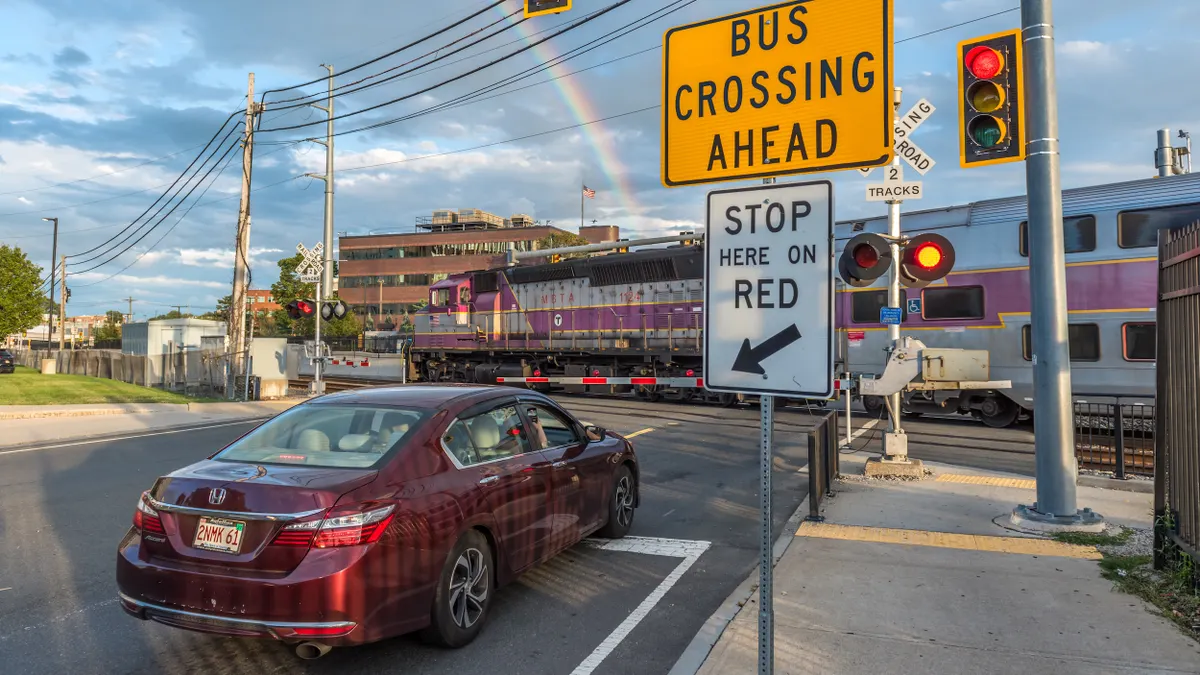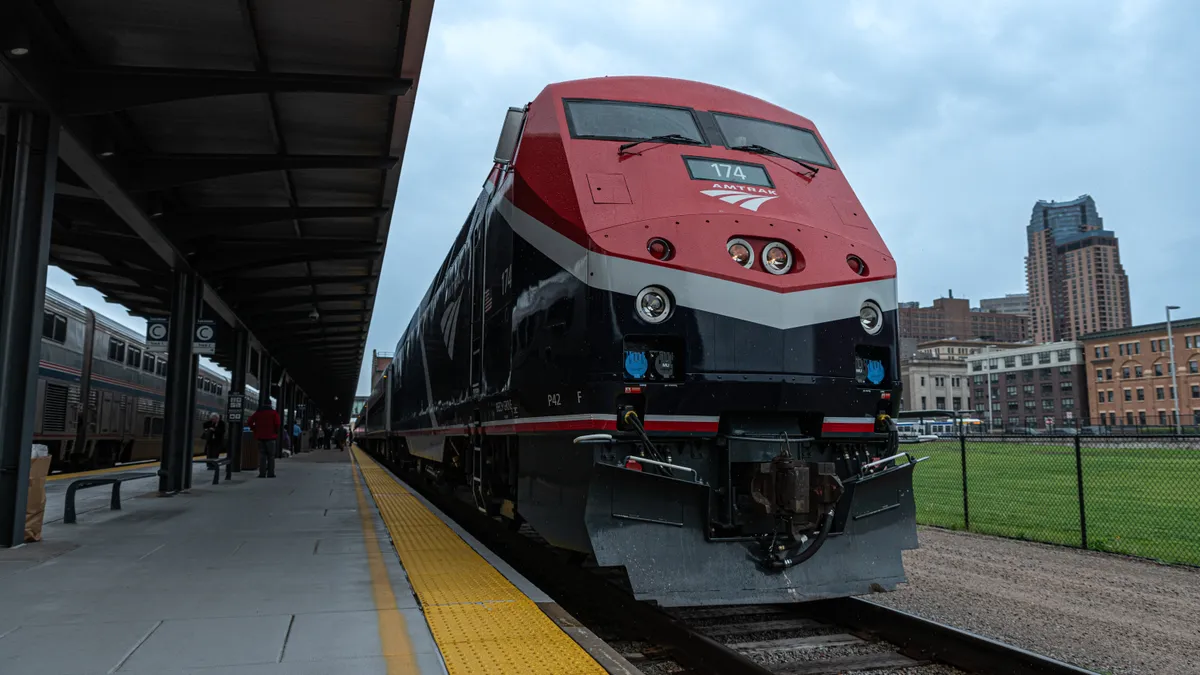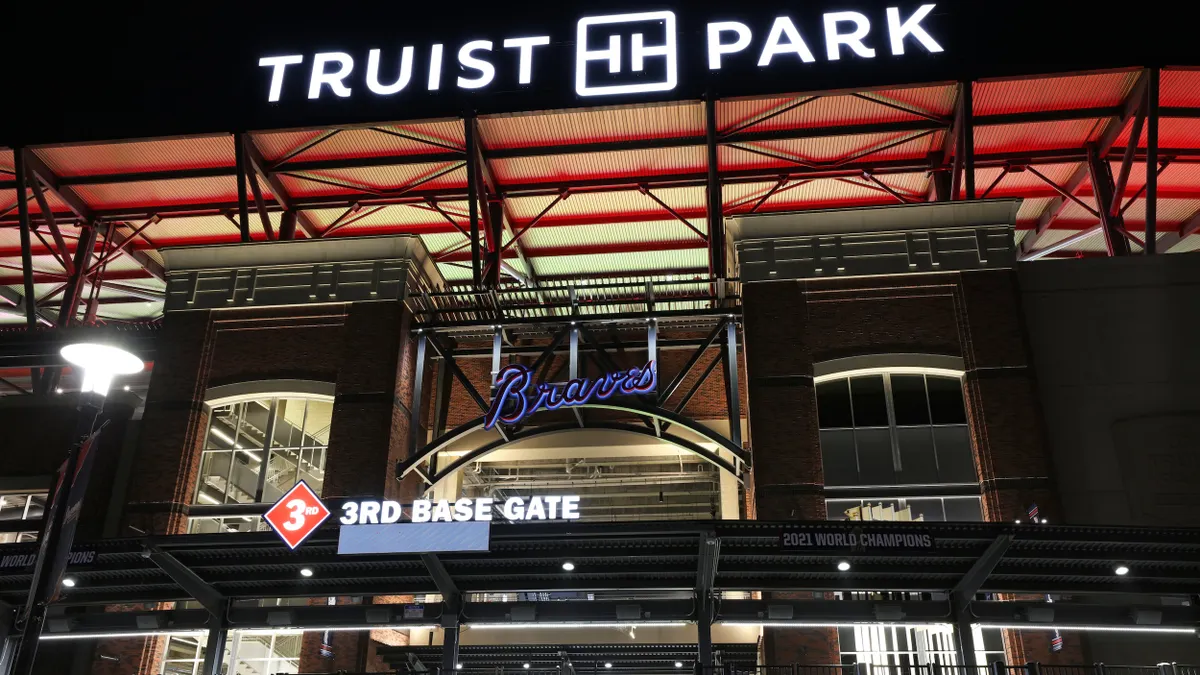In eight years, the world will descend on Los Angeles for the 2028 Summer Olympic and Paralympic Games. Due to the estimated magnitude of attendees and pressures for transportation efficiencies, the city is already looking at how to ready its roads and rails.
So far, local officials have plans to offer more driving alternatives and to cut emissions for improved air quality. With hundreds of thousands of athletes, coaches and spectators set to occupy the already congested city, the looming 2028 deadline may propel efforts to pursue and finalize private and government partnerships that could defray some of the plans' costs.
"We hope [the Olympics] unlock a spirit of collaboration and possibility across jurisdictions, across boundaries," Matt Petersen, president and CEO of the Los Angeles Cleantech Incubator (LACI), told Smart Cities Dive.
Taking a strategic approach to funding
With a reputation as one of the world's most gridlocked cities, Los Angeles officials are already assessing ways to boost public transit and alternative transportation modes to alleviate pressure on city streets ahead of 2028.
The Los Angeles County Metropolitan Transportation Authority (LA Metro) in June 2018 released its Vision 2028 plan, a strategic vision intended to guide the agency's overall strategy to improve mobility. This includes ensuring equitable access to high-quality modes, improving average bus travel speeds and reducing maximum wait times.
The plan envisages "a mobility system that enables people to travel swiftly and easily throughout the LA County region," but adds that "building new roadway capacity without managing the long-term demand for solo driving is not an enduring strategy for meeting the region’s rapidly evolving mobility needs."
In parallel to that, LA Metro’s Board of Directors approved its "Twenty-Eight by '28" plan, which identified 28 capital projects to complete in time for the Games. Those projects, which include a variety of road and transit plans in various stages of completion, are worth an estimated $42.9 billion. Seventeen of the projects have already had financing secured under Measure M, a half-cent sales tax to pay for various transportation fixes and upgrades.
Joshua Schank, LA Metro's chief innovation officer, told Smart Cities Dive that while the Games in 2028 are a good deadline to set for transportation improvements, the need is much more pressing and goes far beyond the summer months of that year. He said using the Olympics lens to rethink how LA optimizes its street space could prompt a change in how people get around in the long-term.
"We think about it this way: We have the best transportation system in the world, we're just not using it as efficiently as we should be," Schank said. "The way we've allocated street space in LA County is on a first-come, first-serve basis for whoever is driving and wherever they want. That is why we have tremendous congestion, because we just let anyone drive at any point, anywhere, almost exclusively without any restriction. If we are able to use that street space more efficiently, we can move a lot more people more rapidly."
A high price tag on projects could be a barrier, but Schank suggested public-private partnerships (P3s) could curb costs. And based on the efforts of previous U.S. Olympic hosts, there is always the potential of leveraging federal funding.
"We hope [the Olympics] unlock a spirit of collaboration and possibility across jurisdictions, across boundaries."

Matt Petersen
President and CEO, Los Angeles Cleantech Incubator
When Salt Lake City hosted the Winter Olympic and Paralympic Games in 2002, the city received money from the federal government to rehabilitate highways and help fund a light rail line that serves the Rice-Eccles Stadium where the opening and closing ceremonies were held. California has not yet asked for federal help, and while its tense relationship with the current administration could make such a request problematic, the Games could be a good hook.
"I would assume they would use that plug, now they've got the Games, to get some federal funding put in place," Greg Thorpe, rail and transit senior project manager in the Northwest Division of consulting firm HNTB, told Smart Cities Dive. Thorpe worked as a consultant to the Utah Sports Authority on designing the Winter Sports Park facility in the run-up to the 2002 Games.
Agencies can also tap into existing opportunities in the county. Mobile ticketing platform Masabi has worked with commuter rail service Metrolink since 2016 to facilitate easy transfers between that system and LA Metro using mobile tickets. Further integrations could be key in helping people move quickly between a smorgasbord of different transit agencies on their way to various venues throughout the area.
"I would just anticipate a continued commitment in LA specifically, but broadly speaking across all our clients, to continue to expand with those clients to serve all riders and to facilitate travel," Zach Ascher, VP of business development at Masabi, told Smart Cities Dive. "In the LA basin, you have over 18 agencies there, so I think there are some questions as to their policy and their longer-term collection modernization strategy."
Floating the idea of congestion pricing
Los Angeles is no stranger to hosting the Olympic Games. When they took over the city in 1984, officials leveraged real-time traffic information, bus rapid transit and a strategy for delivery services, all to keep traffic flowing after fears of crippling gridlock.
Petersen said efforts that year reflected the "can-do spirit of Angelenos across the region."
Similar bold strategies will be necessary for 2028, experts said, and it might start with a congestion pricing scheme, which Schank said could be a good way to raise revenue while encourage and improving alternative transportation modes.
LA Metro CEO Phil Washington has floated the idea that congestion pricing could result in free transit, and Schank said that change in behavior could be key for the city, especially around the time of the Games. He added that much of Vision 2028 would benefit from some form of congestion pricing scheme.
"We need to have all these investments and policy changes that will enable those alternatives to emerge," he said. "It's not going to happen just because people wake up one day and say, 'Wouldn't it be nice for the world if I took transit?' They're going to take transit when it's provided to them as a better alternative."
Partnerships, partnerships, partnerships
Efforts to encourage driving alternatives place a renewed urgency on initiatives like Urban Movement Labs, which Garcetti and a slew of partners unveiled at last year's CoMotion LA conference. Garcetti said the labs will look to expand new mobility solutions, offer job training and workforce development for local residents and build a proving ground to test solutions.
It will also be incumbent on local authorities to work with peer agencies across the country to fill in gaps in execution. In the run-up to the 2002 Winter Games, Thorpe said the Utah Transit Authority (UTA) worked hard on contracts with agencies including Dallas Area Rapid Transit (DART) to borrow rail cars and buses to transport spectators, athletes, coaches and other staff and volunteers between venues. Similar efforts need to begin early, he said, and involve a flurry of legal documents, especially around who is responsible for the cost of damages.
"The city's still operating, it doesn't shut down during the Olympics, so you've got to have extra buses to accommodate all the new visitors, all the coaches and athletes. It's quite an effort," Thorpe said. "They should start planning a year-and-a-half to two years in advance to make sure they can get it organized and make sure they can get buses from other agencies."
Schank said whatever happens, there needs to be a range of solutions so driving alone is not the default option.
"It's not like in 2028, all of a sudden everyone in LA County is going to be living [like those] in New York City and using transit everywhere," he said. "That's not realistic. But what is realistic is that we're going to have way more people using public transit than we do today, way more people choosing modes that are not driving alone than we do today, and that the people who do choose to drive are also going to have a much better customer experience and get where they're going faster."
Breathing cleaner air
Along with the focus to increase transportation options comes work to ensure those options are clean, with a view to dramatic cuts in emissions by 2028.
In late November 2019, LACI and other Transportation Electrification Partnership (TEP) members announced the Zero Emissions 2028 Roadmap 2.0, which aims to reduce air pollution and greenhouse gas emissions (GHG) 25% above existing commitments by 2028 through electrification of the transportation sector. It also sets a goal to have 30% of cars on the road be electric vehicles (EVs) by 2028.
With the city's air quality and pollution a continual sore spot, Petersen said the plan already has admirers in other cities and could set off strong work across the country.
"The city's still operating, it doesn't shut down during the Olympics, so you've got to have extra buses to accommodate all the new visitors, all the coaches and athletes. It's quite an effort."

Greg Thorpe
Senior project manager, HNTB
"Leading by example here, we've shown that LA is leading the way, and that visitors and other people who come in 2028 experience an ability to move emissions-free throughout the region," he said. "But more importantly that our economy has shifted to embrace this opportunity that the solutions are equitably distributed and that other regions are following our lead and hopefully beating us in some cases."
The roadmap, which sets a goal to convert 20% of all single-occupancy vehicles trips to bikes, active transportation or zero-emission public transit, does not have a price tag but suggests numerous policy changes to achieve its goals. Suggestions include an incentive program to encourage EV adoption, and a call for pilot programs to address "gaps in technology, infrastructure, and funding through a set of recommended carrots, sticks, and measures to shape consumer behavior."
Those involved also said it's key to encourage cooperation. "[W]hat we're talking about is so complicated and big and expensive that it's going to take all of us holding hands and working together and sharing resources to do what we need to do, and identify all the pieces," California Air Resources Board (CARB) chair Mary Nichols told reporters during a briefing on the roadmap.
Petersen said the efforts of LACI and its partners in cleaning up the city's air and transportation network in time for 2028 is a tough ask, but certainly possible.
"It gives a very clear sense of possibility and a deadline to work towards, that while 2030 is clear or 2050 or whatever your date, when we started the work in 2018 that was a decade away," Petersen said. "We decided the Olympic and Paralympic Games in 2028 were the best date and sense of urgency we could put in place and mobilize people."




















